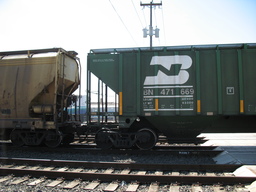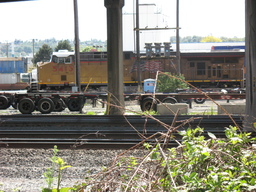Census Taker III
 Seattle, USA
Seattle, USA
May 5, 2009
The trail between north- and southbound I-5 tapered into an off-ramp. I walked along the shoulder of the road--a narrow strip running between slowing traffic and an ivy-covered ridge. I'd taken that freeway exit many times before when driving, but flying by in a car never afforded me the perspective I now had on foot. I paused at a couple memorials built to people who, I presume, had been killed in traffic accidents at that location. Both shrines had been there for years; I had never noticed either before.
As I worked my way out to the end of the off-ramp I spotted a young couple out in the distance, seated beneath a traffic signal. One was holding out a cardboard sign:
TRAVELLING
BROKE
HUNGRY
I said hello as I strolled up to them, just alongside the line of cars halting at the light.
"Whoa! Did you just walk out of the freeway?"
I explained about address canvassing for the Census Bureau in industrial areas. When I asked how they were doing, the young man interpreted my casual question quite specifically: "Not bad. About $24 so far, today. We're hoping to make it down to Arcata."
It wasn't yet noon. Twenty-four dollars was a better take than I would have expected anybody holding a cardboard sign to be given in a full day. We chatted about census-taking and hitch-hiking for a few minutes. I'd never given to anybody begging at a freeway exit before, but figured I could relate to being young and on the road. I gave them what change was in my coin purse and walked on.
This has been a totally different job the last few days. I'm still technically address canvassing, but have been assigned a huge area that is almost completely non-residential. For at least the next week I'll be working the swath of industrial Seattle south of downtown: everything from Chinatown down to Southcenter Mall in Tukwila. I'd guess that to be at least 15 square miles, assigned to me alone. In that huge area there are only about 350 residential addresses listed.
The routine I had of walking door-to-door around a neighborhood block has disappeared. I'm still walking clockwise circuits (as dictated by the census taker's D-675 training manual) to update address records. However, the blocks here are enormous, misshapen, and largely devoid of homes with doors to knock on.
 Block boundaries in this part of town are no longer defined by neatly intersecting paved streets. A block boundary--as defined by the census--is often a railway track or the east bank of the Duwamish River. Even where there are intersecting roads, much of what I'm working are really clusters of several city blocks centered around some industry or business, among them Costco and Starbucks headquarters. These businesses and their parking lots are usually just one part of a "block" I circle on foot. The major courier businesses--UPS, FedEx--also have their main Seattle offices down here. I'm walking a lot of big loops around places that have no residential addresses.
Block boundaries in this part of town are no longer defined by neatly intersecting paved streets. A block boundary--as defined by the census--is often a railway track or the east bank of the Duwamish River. Even where there are intersecting roads, much of what I'm working are really clusters of several city blocks centered around some industry or business, among them Costco and Starbucks headquarters. These businesses and their parking lots are usually just one part of a "block" I circle on foot. The major courier businesses--UPS, FedEx--also have their main Seattle offices down here. I'm walking a lot of big loops around places that have no residential addresses.
The idea of address canvassing is to be able to walk a circuit around roads and paths that define the smallest area, missing no place somebody might live. That works well in a residential neighborhood where homes are laid out along grids: one block forms a neat little rectangle with a couple-dozen houses lining the long sides. In the industrial part of town I'm finding the smallest possible perimeter to circle is often necessarily large. So much of this end of town is chopped up by cargo freight, airfields, and industrial complexes. For example, there would be no way to carve Boeing Field into smaller blocks. The perimeter of that block alone must be miles-long. There simply aren't other paths to walk along than the fence surrounding central airstrip. Thankfully, the runway itself has not been defined as a block boundary I'm required to walk along.
Without doors to knock on, my work is less interactive these days. I still find it enjoyable, but for different reasons. Among them, it's been the perfect time to be out walking around all day; Seattle is getting its first taste of fair weather so far this year. Also, the people I have been talking with are from a wholly different slice of life than those who answered my knocks last week: A homeless man living on the lip of one of the embankments supporting Interstate 5 asked me if I would adopt one of his kittens. (I declined.) He followed up by asking where he could apply for the job I was working. I felt bad, as the best direction I could offer was a leaflet with the address "census.gov"--I doubt he had access to a telephone, let alone the Internet.
Further into the same block, still walking underneath the freeway, I came across some of the best graffiti I've seen. Somebody has turned the pillars beneath I-5 at South Oregon Street into their personal canvas. Huge, colorful murals flow around the columns and retaining walls. The art is in an obscure location; it's clearly an area that nobody would care to re-paint. To get up to that stretch of land it's necessary to scale a slope and walk through brush and trees. I never would have gone up there myself if it hadn't been part of an area the Census assigned me to canvas.
The one area of industrial Seattle I actually am familiar with is along the bottom of that slope. Running parallel beneath the stretch of freeway connecting the traveling teenage couple to the homeless man with kittens to the great graffiti murals are the tracks where the freight trains are loaded.
Back in high school, a few classmates and I tried on occasion to catch freight trains out of that yard. We didn't know what we were doing and were spectacularly unsuccessful. Our destination was always Portland. One time we got on a train that took us in the opposite direction, stopping just shy of downtown Seattle. Riding another train left a friend with two broken arms. We never did make it out of the city.
I hadn't been down along those tracks since then. I couldn't believe I was actually being paid to be out on a sunny day, tramping about the large gravel lining the rails. Occasionally, a freight train would chug through. Seeing the boxcars brought on a wave of nostalgia, though there were minor changes to what I remembered. A fancy passenger train labeled "Amtrak Mt. Olympus Cascades" zipped through as I walked along parallel tracks. I don't recall seeing that line before. Some of the freight cars have a new logo: BNSF. Did Burlington Northern merge with Santa Fe? Those were rival companies the last I knew.
Only one more month left to work this job. I'm eager to see where I wind up next...
 Block boundaries in this part of town are no longer defined by neatly intersecting paved streets. A block boundary--as defined by the census--is often a railway track or the east bank of the Duwamish River. Even where there are intersecting roads, much of what I'm working are really clusters of several city blocks centered around some industry or business, among them Costco and Starbucks headquarters. These businesses and their parking lots are usually just one part of a "block" I circle on foot. The major courier businesses--UPS, FedEx--also have their main Seattle offices down here. I'm walking a lot of big loops around places that have no residential addresses.
Block boundaries in this part of town are no longer defined by neatly intersecting paved streets. A block boundary--as defined by the census--is often a railway track or the east bank of the Duwamish River. Even where there are intersecting roads, much of what I'm working are really clusters of several city blocks centered around some industry or business, among them Costco and Starbucks headquarters. These businesses and their parking lots are usually just one part of a "block" I circle on foot. The major courier businesses--UPS, FedEx--also have their main Seattle offices down here. I'm walking a lot of big loops around places that have no residential addresses.
 Seattle, USA
Seattle, USA